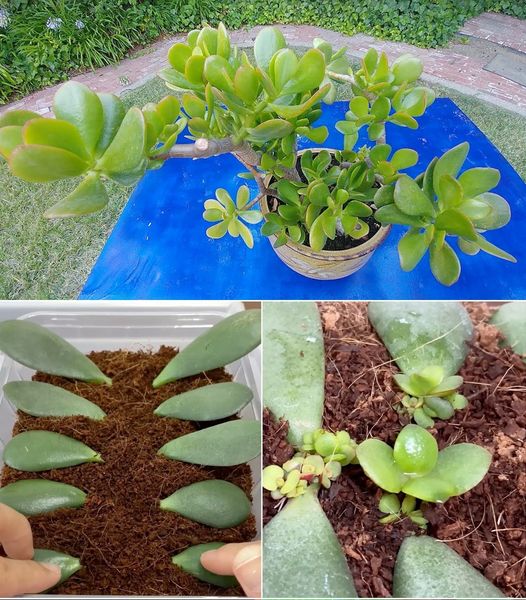
Jade Plant Propagation: A Beginner’s Guide
The Jade plant, recognized scientifically as Crassula ovata, is gaining popularity amongst both indoor and outdoor plant enthusiasts.
Hailing from the lands of South Africa, these hardy succulents are notably durable and thrive unless drenched excessively. Given their robust nature and appealing aesthetics, it’s no wonder that they’re a favorite for propagation.
Initiating propagation of these plants is a straightforward affair. As spring arrives, you can choose to propagate from either stem or leaf cuttings.

While stem cuttings tend to sprout into mature plants more rapidly, leaf cuttings can be ideal for those who own smaller Jade plants without sizable branches for rooting.
Whether you opt for stems or leaves, the steps are user-friendly for indoor and outdoor settings alike. With a sprinkle of patience, you’ll be rewarded with a fresh Jade offspring without spending a dime.
Steps to Propagate Jade Using Stem Cuttings
1. Selecting the Ideal Stem

To optimize the rooting potential, always initiate with a flourishing, disease-free plant. Equally crucial is determining the optimum spot to sever, both to expedite the rooting and to maintain the aesthetics of the mother plant.
Eye the junctures where leaves merge with the primary stem. A stem segment of approximately 4 inches, from such a point to its end, is ideal. If your Jade plant is relatively young and lacks long cuttings, consider smaller stem portions or leaf propagation.
2. Execute the Cut

Arm yourself with clean, sharp pruning shears or a knife. Ensure they’re devoid of contaminants, as you don’t want to introduce any pathogens to your cuttings or the donor plant.
Endeavor a clean, smooth cut of 4 inches, evading jagged incisions. Depending on your objective, cut just beneath a node for full branch removal, or above one to stimulate further growth. In the latter scenario, snip off the surplus stem so that the node rests at the cutting’s base.

For best results, strip the lower half of the cutting of its leaves, retaining only a couple at the peak. This not only unveils more nodes for better soil anchorage during rooting but also channels the plant’s energy towards root formation rather than leaf sustenance.
3. The Callousing Phase

Those familiar with tropical plant propagation might find this step unique. While it’s tempting to root your cuttings immediately, patience is pivotal here. Direct planting can make your cutting susceptible to decay.
Being a succulent, Jade plants need their cuts to harden before they touch the soil, safeguarding them from excessive moisture that might lead to rot.
The procedure is hassle-free: position the cutting on a flat surface, perhaps a newspaper, and let it sit for several days, although nearing a week is ideal. Once you notice the cuts beginning to harden or “callous”, you’re all set for rooting.
Planting in Soil

When preparing for planting, the soil mix you select is vital. A well-draining succulent-specific potting mix, if available, works wonders. Alternatively, create a bespoke blend by mixing coconut coir and perlite or river sand in equal proportions.

Once your pot is filled with the chosen mix, saturate it until you see water dribbling from its base drain. This helps avoid overhydration and firms up the soil, making the planting process smoother.
Then, create a depression in the soil’s center using your finger. Place the cutting inside, ensuring half of it is beneath the soil. Firmly pat the surrounding soil to secure the cutting.
Nurturing the Cutting

Shift the pot to a temperate location to stimulate root growth. It’s essential to maintain a moist (but not soggy) soil environment until roots form. Once the roots attain a few inches in length, lessen the watering frequency. At this stage, the Jade cutting’s care should mimic that of a mature plant.
Leaf Propagation Steps for Jade Plants
1. Selecting an Ideal Leaf

Stem propagation principles apply to leaves too: start right to end right. Seek out leaves that are robust, vividly green, and devoid of any ailments or pests. A leaf from a vigorous stem promises the best rooting outcome.
2. Leaf Detachment

This seemingly simple step requires precision. For a leaf cutting to genuinely foster roots and baby plants, it must retain a portion of the stem’s node. A random snip won’t always result in root formation.
To detach a leaf, it’s crucial to get as close to its base as possible, ensuring you retain some node. Either twist it off gently or use a precise cut at the stem, but avoid distorting the leaf’s structure, as this could jeopardize successful rooting.
3. Pre-planting Care

Analogous to stems, leaves demand a brief period to heal their cut wounds prior to planting. This minimizes the risk of decay, ensuring successful rooting. A quick drying session on newspaper over a day or two will suffice.
4. Sowing Leaf Cuttings in Soil

The soil mix suitable for stem cuttings is equally apt for leaf cuttings. You might even intersperse some leaf cuttings with stem cuttings in one pot to augment your Jade collection. Monitor soil dampness closely, as leaves are prone to decay if they remain wet for extended durations.
Avoid embedding the leaf too deep into the soil to ward off rot. Only the base of the cutting, where roots will sprout, should be submerged. Alternatively, simply lay the leaf atop the soil and sprinkle a thin layer of potting mix to boost root emergence.
5. Subsequent Care

Positioned in a warm locale with consistent soil moisture, the leaf will exhibit fresh growth at its base within a month or two. Allow the emerging plant to grow within its original pot until it’s sizable enough, after which you can rehome it in a succulent-specific mix.

While Jade plants cultivated from leaf (or smaller stem) cuttings may demand a longer growth period, the gratifying results are truly worth the patience.
